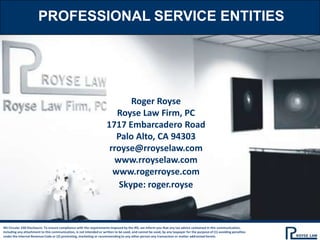
Professional Service Entities Power Point
- 1. PROFESSIONAL SERVICE ENTITIES Roger Royse Royse Law Firm, PC 1717 Embarcadero Road Palo Alto, CA 94303 rroyse@rroyselaw.com www.rroyselaw.com www.rogerroyse.com Skype: roger.royse IRS Circular 230 Disclosure: To ensure compliance with the requirements imposed by the IRS, we inform you that any tax advice contained in this communication, including any attachment to this communication, is not intended or written to be used, and cannot be used, by any taxpayer for the purpose of (1) avoiding penalties under the Internal Revenue Code or (2) promoting, marketing or recommending to any other person any transaction or matter addressed herein.
- 2. What is the Right Legal Structure For Your Law Firm? Law Corporation Rules Fee and State Bar Registration Certificate from SoS Each Shareholder is active Member of the Bar Death, disability or disbarment Name Insurance or Undertaking ($50k per claim/$100k aggregate per lawyer) Legended stock certificates Bylaw restrictions Circular 230
- 3. Ethical Issues IRS Circular 230 restricts the firm‟s practice before the IRS if any partners violate certain rules. The entity name is a “communication,” subject to Rule 1-400. The duties set forth in Rule 3-110 include the duty to supervise the work of subordinate attorney and non-attorney employees or agents.
- 4. Legal Requirements Sole PC State bar and Rule 1-400 compliance • Each partner must be an active bar member or an eligible law corporation • State bar and Rule 1-400 compliance • “RLLP” or “LLP” • Certification • Security • Moscone-Knox PC Act • Licensed shareholders • State bar and Rule 1-400 compliance • Generally joint and several liability • Registration • Security LLP
- 5. Liability Protection Sole PC Protection not provided. Protection provided, exce pt for personal negligence. Protection provided, except for the professional (and employees)‟s malpractice and payroll tax claims. LLP
- 6. Income Tax C Corp. S Corp. • Corporate level tax. Maximum rate of 35% plus 9.3% California • Tax free formation, taxable distribution • Excludible benefits • Deduction for Compensation • Pass-through • Tax free contributions and distributions • $800 annual minimum tax • 39% Individual rate • Pass-through, subject to excess net passive income tax rules • 100 or less US-person individuals or trusts • Single class of stock • Certain benefits for < 2% shareholders • Tax free formation, taxable distribution LLP
- 7. Self- Employment and Payroll Taxes LLP Self- Employment Tax PC Payroll Tax Self Employment Taxes (SET): Partner: 12.4% Medicare tax: (no max base) Partner: 2.9% > $200k (single) or $250k (MFJ): Earned income: 0.9% (Passive income: 3.8% NIT) Social security (max base $113,700). Employee: 6.2% / Employer: 6.2% No SET / Limited NIT Reasonable Compensation Medicare (no max base) Employee:1.45% / Employer 1.45% > $200k (single) or $250k (MFJ): Earned income: 0.9% (Passive income: 3.8%)
- 8. Employee Benefits C Corp. S Corp. Deductible by corporation—not included in income of employee Cash value of fringe benefits not excludable from partner‟s income or deductible by the partnership (guaranteed payment) Cash value of fringe benefits generally not excludable from > 2% owner-employee‟s income or deductible by S corporation (W-2 wages) LLP
- 9. Methods of Accounting C Corp. S Corp. Generally accrual method if the C corporation‟s annual gross receipts exceed $5 million. Must use accrual method if a C Corporation is a partner, unless the partnership has less than $5 million gross receipts per year. Must use accrual method if the S corporation maintains inventory. LLP
- 10. Compensation / Distribution Policies Gross Split Net Split Salaried Subjective C Corp. S Corp. Deductible expenses Compensatory bonuses Special allocation / distributions based on gross or net revenues or a custom formula allowed; substantial economic effect required Second class of stock rule Compensatory bonuses LLP
- 11. Other Policies and Provisions Write Offs Expenses CLE Firm Name Titles Staff & Associates Non–Equity Partners Practice Areas Office Locations
- 12. Liquidation and Dissolution C Corp. S Corp. Amounts distributed in complete liquidation are treated as full payment in exchange for the stock Shareholder level tax on liquidation Jewel v. Boxer: “unfinished business” doctrine / “no compensation rule”— profits earned by former firm partners at their successor firms are „old LLP‟ assets One level of tax Amounts distributed in complete liquidation are treated as full payment in exchange for the stock Generally capital gain on stock sale LLP
- 13. The Future of Law Practice Jacoby & Meyers case OnLine Solutions (RoyseLaw Incorporator) Crowdsourced solutions (Rocket Lawyer) Pooled resources (Lexis-Nexis, Lawyers.com) Legal Force model
- 14. RoyseLaw Legal Wizard RoyseLaw Incorporator 32
- 15. www.rroyselaw.com @RoyseLaw PALO ALTO 1717 Embarcadero Road Palo Alto, CA 94303 LOS ANGELES 1150 Santa Monica Blvd. Suite 1200 Los Angeles, CA 90025 SAN FRANCISCO 135 Main Street 12th Floor San Francisco, CA 94105 Palo Alto Office: 650-813-9700 Contact Us
- 16. The discussion of tax consideration was not intended or written to be used, and cannot be used, by any taxpayer for the purpose of avoiding tax penalties that may be imposed by the Internal Revenue Service. Each party should seek advice based on the party‟s particular circumstances from an independent tax advisor. In accordance with Section 6694 of the Internal Revenue Code of 1986, as amended (the “Code”), we hereby advise you that the positions set forth herein may lack substantial authority and, therefore, may be subject to penalty under Code section 6662(d) unless adequately disclosed on IRS Form 8275. Circular 230 Disclosure
